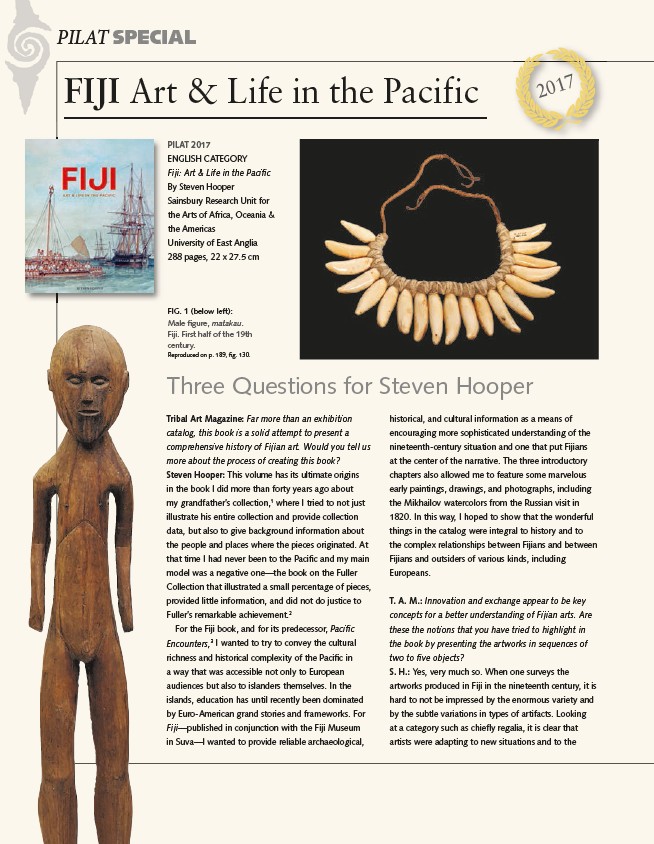
PILAT SPECIAL
FIJI Art & Life in the Pacific
132
2017
PILAT 2017
ENGLISH CATEGORY
Fiji: Art & Life in the Pacifi c
By Steven Hooper
Sainsbury Research Unit for
the Arts of Africa, Oceania &
the Americas
University of East Anglia
288 pages, 22 x 27.5 cm
FIG. 1 (below left):
Male fi gure, matakau.
Fiji. First half of the 19th
century.
Reproduced on p. 189, fi g. 130.
Three Questions for Steven Hooper
Tribal Art Magazine: Far more than an exhibition
catalog, this book is a solid attempt to present a
comprehensive history of Fijian art. Would you tell us
more about the process of creating this book?
Steven Hooper: This volume has its ultimate origins
in the book I did more than forty years ago about
my grandfather’s collection,1 where I tried to not just
illustrate his entire collection and provide collection
data, but also to give background information about
the people and places where the pieces originated. At
that time I had never been to the Pacifi c and my main
model was a negative one—the book on the Fuller
Collection that illustrated a small percentage of pieces,
provided little information, and did not do justice to
Fuller’s remarkable achievement.2
For the Fiji book, and for its predecessor, Pacifi c
Encounters,3 I wanted to try to convey the cultural
richness and historical complexity of the Pacifi c in
a way that was accessible not only to European
audiences but also to islanders themselves. In the
islands, education has until recently been dominated
by Euro-American grand stories and frameworks. For
Fiji—published in conjunction with the Fiji Museum
in Suva—I wanted to provide reliable archaeological,
historical, and cultural information as a means of
encouraging more sophisticated understanding of the
nineteenth-century situation and one that put Fijians
at the center of the narrative. The three introductory
chapters also allowed me to feature some marvelous
early paintings, drawings, and photographs, including
the Mikhailov watercolors from the Russian visit in
1820. In this way, I hoped to show that the wonderful
things in the catalog were integral to history and to
the complex relationships between Fijians and between
Fijians and outsiders of various kinds, including
Europeans.
T. A. M.: Innovation and exchange appear to be key
concepts for a better understanding of Fijian arts. Are
these the notions that you have tried to highlight in
the book by presenting the artworks in sequences of
two to fi ve objects?
S. H.: Yes, very much so. When one surveys the
artworks produced in Fiji in the nineteenth century, it is
hard to not be impressed by the enormous variety and
by the subtle variations in types of artifacts. Looking
at a category such as chiefl y regalia, it is clear that
artists were adapting to new situations and to the